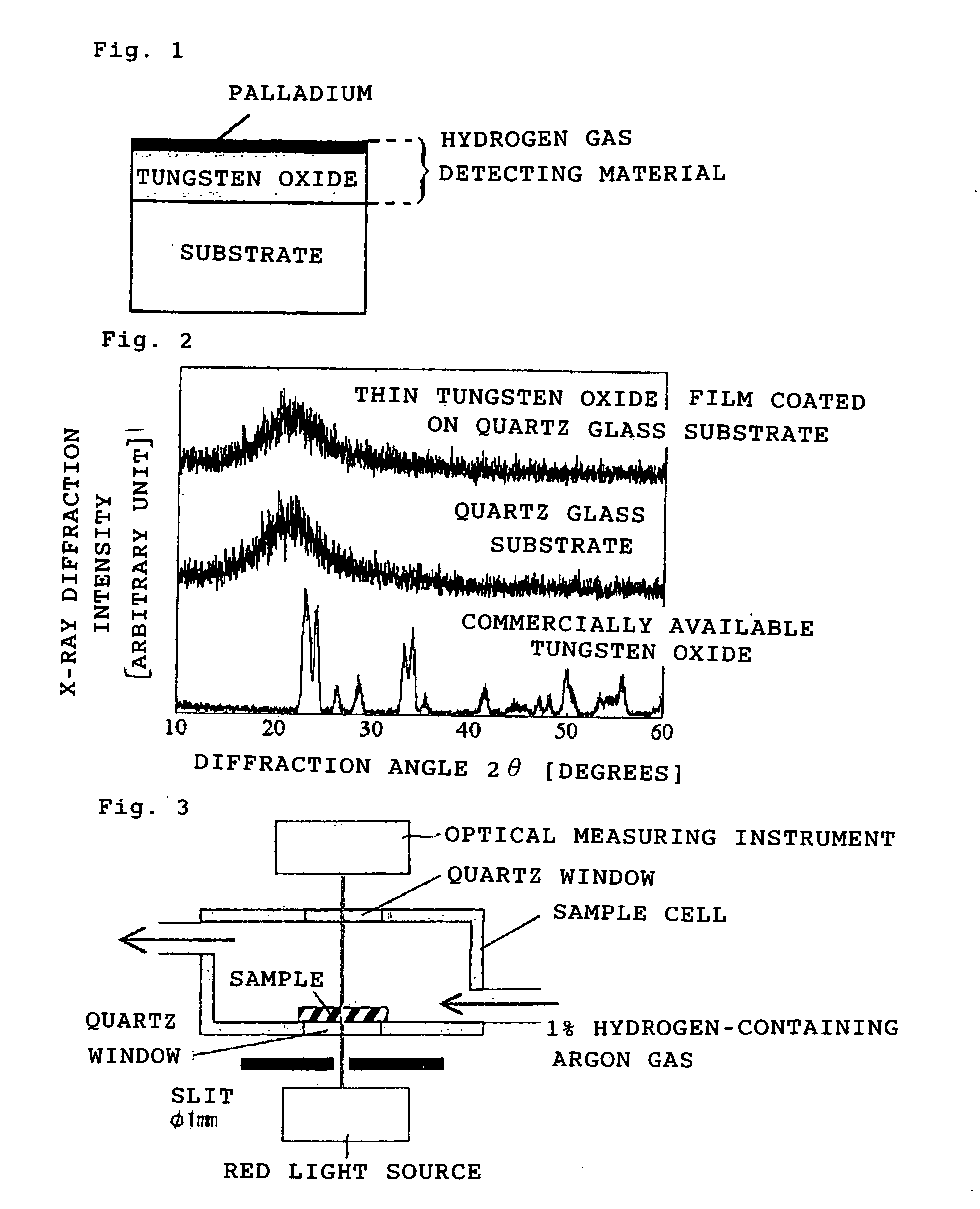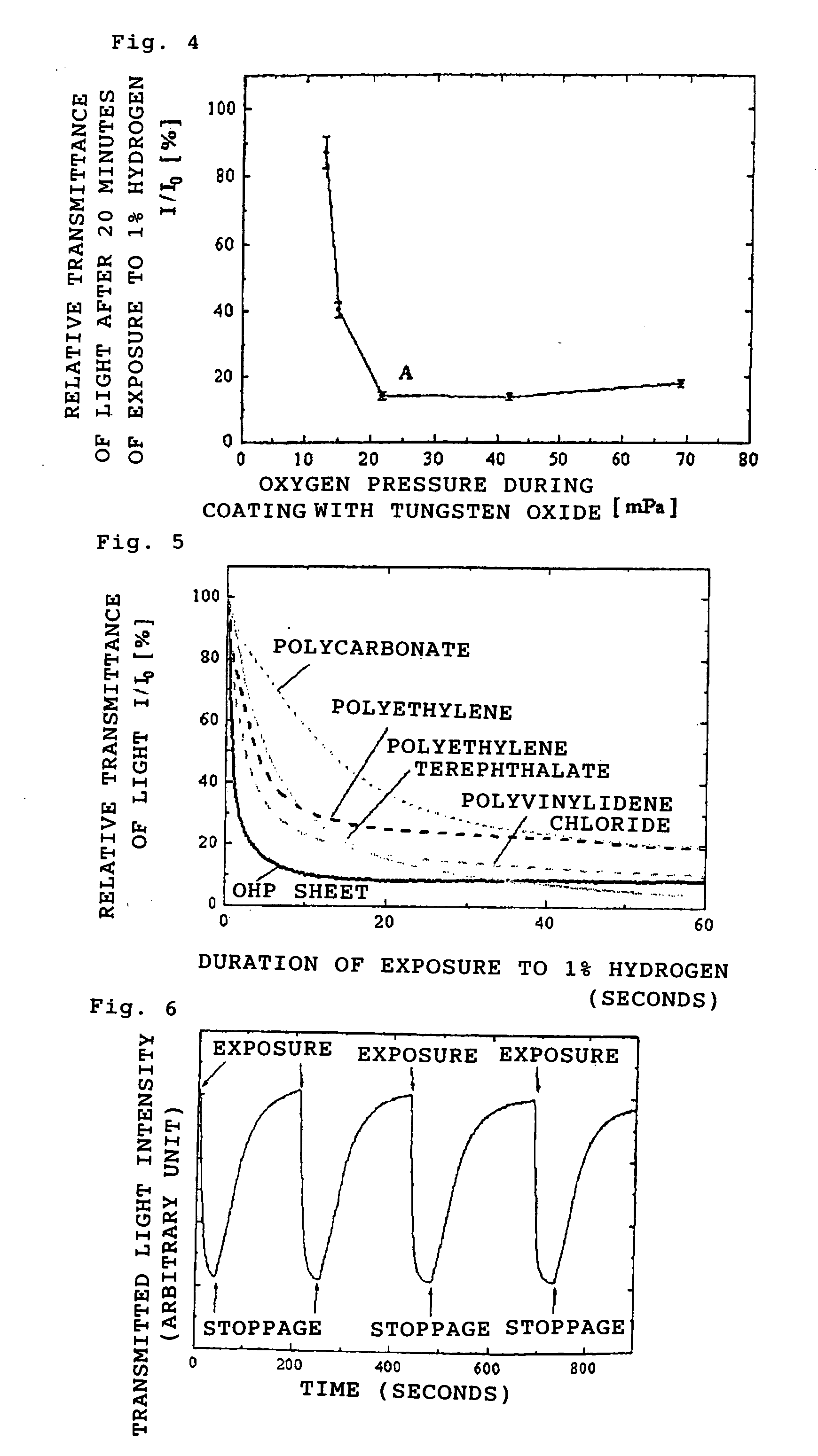Hydrogen Gas Detecting Material and the Coating Method
- Summary
- Abstract
- Description
- Claims
- Application Information
AI Technical Summary
Benefits of technology
Problems solved by technology
Method used
Image
Examples
example 1
[0020]In Example 1, a thin film of tungsten oxide was coated on the surface of a quartz glass substrate 20 mm long, 20 mm wide and 0.5 mm thick, in order to evaluate the crystal structure of the coated tungsten oxide and optimize its hydrogen detecting characteristics. The tungsten oxide film was coated by using tungsten as a target and sputtering the metallic tungsten target for 30 minutes at a power of 50 W while setting the distance between the substrate and the target at 10 cm, setting the substrate temperature at room temperature, and controlling the atmosphere to have an argon gas partial pressure of 148 mPa and an oxygen partial pressure of 22 mPa. The film thickness of tungsten oxide was of the order of 0.3 μm.
[0021]The results of evaluation of the crystallinity of the coated film by X-ray diffraction are shown in FIG. 2. A Cu Kα radiation was used as a radiation source. A diffraction peak with a large width was observed around a diffraction angle of 23 degrees, but no other...
examples 4 to 8
[0026]Hydrogen gas detecting materials were produced using each of a 1.2 mm thick polycarbonate plate, a 40 μm thick polyethylene sheet, a 11 μm thick polyvinylidene chloride (Saran Wrap, ASAHI CHEMICAL INDUSTRY CO., LTD.), a 100 μm thick OHP sheet (a product of Fuji Xerox Co., Ltd.), and a 100 μm thick polyethylene terephthalate (PET) sheet as a substrate, and adopting the same coating conditions as in Example 1. The hydrogen gas detecting materials were each examined for the light absorption characteristics responsive to a hydrogen gas in the same manner as in Example 1. FIG. 5 shows changes gradually in the relative transmittance of the hydrogen gas detecting material when exposed to hydrogen. The relative transmittances of the hydrogen gas detecting materials coated on polycarbonate (Example 4), polyethylene (Example 5), polyvinylidene chloride (Example 6), OHP (Example 7), and PET (Example 8), after 60 seconds of exposure to hydrogen, were 20%, 20%, 11%, 9% and 4%, respectively...
example 9
[0027]Changes over time in the transmitted light intensity were examined when an operation involving exposure to a hydrogen gas and its stoppage was performed a plurality of times under the same measuring conditions as in Example 1 for the hydrogen gas detecting material coated on the 100 μm PET sheet in Example 6. The results are shown in FIG. 6. The hydrogen gas detecting material restored transmittance when the hydrogen gas was stopped, namely, when the hydrogen gas was no more existent in the surroundings. Thus, the light absorption characteristics of the hydrogen gas detecting material were found to be reversible in response to the hydrogen gas. When the operation involving exposure to the hydrogen gas and its stoppage was performed repeatedly, a decrease in and the restoration of the transmittance appeared recurrently. Thus, the hydrogen gas detecting material can detect a hydrogen gas repeatedly.
PUM
| Property | Measurement | Unit |
|---|---|---|
| Temperature | aaaaa | aaaaa |
| Thickness | aaaaa | aaaaa |
| Temperature | aaaaa | aaaaa |
Abstract
Description
Claims
Application Information
 Login to View More
Login to View More - R&D
- Intellectual Property
- Life Sciences
- Materials
- Tech Scout
- Unparalleled Data Quality
- Higher Quality Content
- 60% Fewer Hallucinations
Browse by: Latest US Patents, China's latest patents, Technical Efficacy Thesaurus, Application Domain, Technology Topic, Popular Technical Reports.
© 2025 PatSnap. All rights reserved.Legal|Privacy policy|Modern Slavery Act Transparency Statement|Sitemap|About US| Contact US: help@patsnap.com



